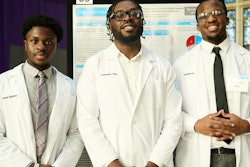The White House’s proposed $5.8 billion cut to the National Institutes of Health would be “devastating to the American people” and a “dramatic setback to medical progress.”
Those are some of the assessments proffered about the preliminary budget released earlier this year by the administration of President Donald J. Trump. A more detailed budget is expected in the coming weeks.
 Dr. Raynard S. Kington, president of Grinnell College, is former acting director of NIH under President George W. Bush and President Barack H. Obama.
Dr. Raynard S. Kington, president of Grinnell College, is former acting director of NIH under President George W. Bush and President Barack H. Obama.One of the fiercest opponents of the proposed $5.8 billion cut to NIH — which would take the federal agency’s spending down to $25.9 billion — is Grinnell College president Dr. Raynard S. Kington, former acting director of NIH under President George W. Bush and President Barack H. Obama.
Kington said the proposed cuts to NIH “suggest an extraordinary level of ignorance about the important new knowledge and innovation that comes out of that funding.”
“I think it would be devastating to the American people to implement the cuts that are being proposed,” Kington said. “I just think the proposals are short-sighted, they are anti-knowledge, anti-intellectual, and they just would be extraordinarily bad for the future and well-being of our country.”
Kington cited the need for a “whole continuum” of research in order to make new medical breakthroughs on things that range from childhood leukemia to obesity. He said the private sector is “never going to do the basic research in a way that a developed society needs.”
Kington is by no means the lone critic of the proposed cuts to NIH.
Suzanne Ffolkes, vice president of communications at Research!America, an Arlington, Virginia-based nonprofit public education and advocacy alliance, decried the proposed cuts as “a dramatic setback to medical progress.”
“Americans who expect research to advance at the level of scientific opportunity will be deeply concerned about the short- and long-term impact of steep funding cuts as it relates to the discovery, development, and delivery of new treatments to complex diseases and finding cures,” Ffolkes said.
She said robust investments are necessary to support public and private sector research and new technology that helps to deepen scientific understanding of genetic mutations and cancer cells.
“If we hope to continue to make great strides in immunotherapy treatment for cancer, for example, we must have sustained, predictable increases for the NIH,” Ffolkes said.
Ffolkes cited statistics from a Research!America survey that found 63 percent of Americans “agree that basic scientific research, even if it brings no immediate benefits, should be supported by the federal government.”
The survey also found that more than half — 52 percent — are willing to pay $1 per week more in taxes if they were certain that all of the money would be spent on additional medical research.
“Patients anxiously waiting for the next medical breakthrough to improve their quality of life will be impacted, as innovative studies are shelved or delayed by insufficient funding,” Ffolkes said. “The careers of many young scientists will be in jeopardy as they compete for fewer grants.”
NIH explains on this webpage about its budget that it invests “nearly $32.3 billion annually in medical research for the American people.”
“More than 80 percent of the NIH’s funding is awarded through almost 50,000 competitive grants to more than 300,000 researchers at more than 2,500 universities, medical schools, and other research institutions in every state and around the world,” the page states.
This link shows nearly 14,000 projects funded by NIH at institutions of higher education in fiscal 2017. The projects range from a $4.9 million project at Duke University known as “Duke Clinical Good Manufacturing Practices Facility for HIV/AIDS Vaccine Production,” to a $118,000 project at Howard University titled “Genetic Signatures Underlying Prostate Cancer Metastasis in African Americans.”
Diverse reached out to the NIH for comment but was referred to a statement issued earlier this year by Health and Human Services Secretary Tom Price. HHS is the parent agency of NIH.
“HHS is dedicated to fulfilling our department’s mission to improve the health and well-being of the American people,” Price said in the statement. “This budget supports that mission and will help ensure we are delivering critical services to our fellow citizens in the most efficient and effective manner possible.”
Kington, the former NIH head, had no shortage of examples of medical breakthroughs that came out of the NIH to demonstrate the agency’s value.
For instance, he said the AZT treatment that helps treat sufferers of HIV came out of NIH — as documented in this brief history that mentions the role that Duke University played in the first trials.
“Millions of people are alive today who wouldn’t be alive otherwise,” Kington said.
Dr. Louis J. DeGennaro, president and CEO of The Leukemia & Lymphoma Society, also decried the proposed cuts to NIH.
“These cuts risk derailing decades of advancement in the diagnosis, understanding and treatment of deadly blood cancers,” DeGennaro said in a statement that calls on members of Congress to reject the cuts to NIH.
“While the Budget Blueprint is not clear as to how cuts will be applied, if they are allocated proportionally across NIH, they represent a nearly $1 billion cut to the National Cancer Institute (NCI), which will devastate the landscape of cancer research,” DeGennaro said.
He noted that the budget cuts would be “widespread and much broader than just blood cancer.”
Jamaal Abdul-Alim can be reached at [email protected] or you can follow him on Twitter @dcwriter360.



















